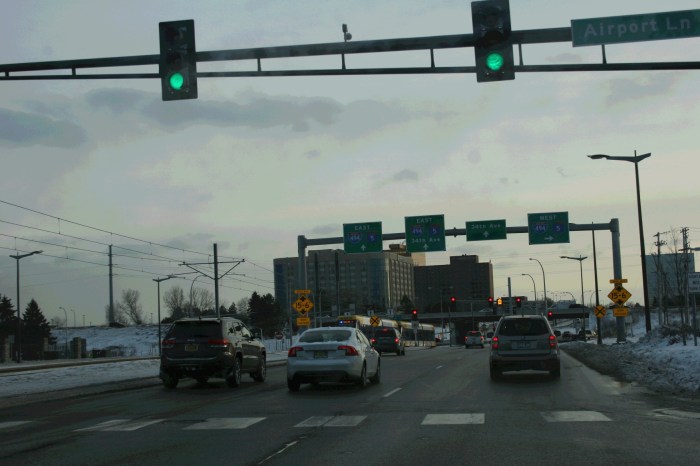What is a light rail intersection – Light rail intersections are unique and critical components of urban transportation systems, offering a seamless blend of safety, efficiency, and connectivity. This comprehensive guide delves into the intricacies of light rail intersections, exploring their definition, types, design principles, safety measures, and the numerous benefits they bring to modern cities.
Light rail intersections are specialized junctions where light rail lines intersect with other roadways or pedestrian paths. Unlike traditional intersections, they incorporate unique features such as tracks, signals, and platforms to facilitate the safe and efficient movement of light rail vehicles, pedestrians, and other traffic.
What is a Light Rail Intersection?

A light rail intersection is a junction where a light rail line crosses another roadway or pedestrian path. It is designed to allow light rail vehicles (LRVs) to pass through the intersection safely and efficiently while minimizing disruption to other traffic.
Light rail intersections differ from other types of intersections in that they typically have dedicated tracks for LRVs, as well as signals and platforms to facilitate passenger boarding and disembarking.
Types of Light Rail Intersections
There are several types of light rail intersections, each with its own advantages and disadvantages:
- At-grade intersections:These are the most common type of light rail intersection, where the tracks are at the same level as the road surface. They are relatively inexpensive to construct and maintain, but they can be less safe for pedestrians and vehicles due to the potential for collisions.
- Grade-separated intersections:These intersections are built on separate levels, with the tracks either elevated or underground. This type of intersection is more expensive to construct, but it is also safer for pedestrians and vehicles.
- Signalized intersections:These intersections have traffic signals that control the movement of LRVs and other traffic. They are typically used at busy intersections to improve safety and traffic flow.
Design and Planning of Light Rail Intersections
The design and planning of light rail intersections is a complex process that involves a number of factors, including:
- Traffic flow:The intersection must be designed to accommodate the flow of traffic, both vehicular and pedestrian.
- Pedestrian safety:The intersection must be designed to ensure the safety of pedestrians, both at the intersection itself and in the surrounding area.
- Accessibility:The intersection must be accessible to all users, including people with disabilities.
Engineers and urban planners play a key role in designing and planning light rail intersections that are efficient, safe, and accessible.
Safety at Light Rail Intersections, What is a light rail intersection
Light rail intersections can be dangerous locations, as they involve the interaction of LRVs, vehicles, and pedestrians. The following measures are implemented to enhance safety at light rail intersections:
- Traffic signals:Traffic signals control the movement of LRVs and other traffic, reducing the risk of collisions.
- Pedestrian crossings:Pedestrian crossings are marked with signs and signals to indicate where pedestrians should cross the tracks.
- Enforcement:Law enforcement officers can be present at light rail intersections to enforce traffic laws and deter dangerous behavior.
Despite these measures, light rail intersection accidents do still occur. It is important for all users to be aware of the hazards and to take precautions to stay safe.
Benefits of Light Rail Intersections
Light rail intersections offer a number of benefits, including:
- Improved traffic flow:Light rail intersections can help to improve traffic flow by reducing congestion and delays.
- Reduced emissions:Light rail vehicles are more efficient than cars and buses, so they produce fewer emissions.
- Increased connectivity:Light rail intersections can help to connect different parts of a city, making it easier for people to get around.
Light rail intersections are an important part of sustainable urban transportation. They can help to reduce traffic congestion, improve air quality, and make cities more livable.
Questions and Answers: What Is A Light Rail Intersection
What are the key characteristics of a light rail intersection?
Light rail intersections are typically characterized by the presence of tracks, signals, and platforms, which facilitate the safe and efficient movement of light rail vehicles, pedestrians, and other traffic.
What are the different types of light rail intersections?
There are various types of light rail intersections, including at-grade, grade-separated, and signalized intersections, each with its own advantages and disadvantages.
How are light rail intersections designed and planned?
The design and planning of light rail intersections involve careful consideration of factors such as traffic flow, pedestrian safety, and accessibility, with engineers and urban planners playing a crucial role in creating efficient and safe intersections.
What safety measures are implemented at light rail intersections?
To enhance safety at light rail intersections, various measures are employed, including traffic signals, pedestrian crossings, and enforcement, with a focus on minimizing potential hazards and risks.
What are the benefits of light rail intersections?
Light rail intersections offer numerous benefits, including improved traffic flow, reduced emissions, increased connectivity, and enhanced livability, contributing to sustainable urban transportation systems.
